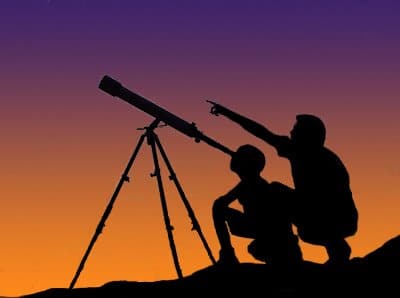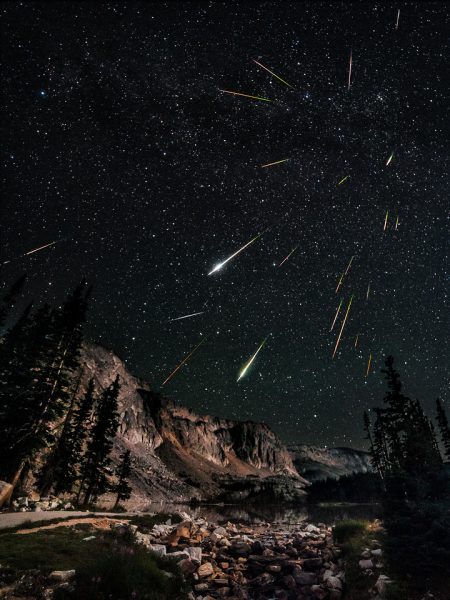
Perseid Meteor Shower 2023 – There are many things to see when you look up during any clear night. Stars, planets, satellites, the moon and more. But there is nothing more breathtaking than seeing a meteor. Otherwise known as a shooting star. Occasionally, you can see many meteors/ shooting stars over the course of a few evenings. These are known as meteor showers. In August we have the best and most well-known meteor shower of the year – The Perseid Meteor Shower, also known as the Perseids.
Why Is The Perseid Meteor Shower So Special?
To many people who have seen them before, the Perseids are very memorable. They occur in August and some people may have seen them while on holiday. Somewhere special, or just in their back garden. Because they occur in August, it usually means it’s warm. It’s more likely that people will spend an extended amount of time outside under the stars. Providing it’s not cloudy or raining which can ruin the whole thing.
Having a night out, or even an hour or two under the stars can be magical. The Perseid Meteor Shower August is the perfect excuse. Sit in a garden chair, or lay back on a deck chair or recliner. Lay on a trampoline or an air bed. The choice is yours. All you have to do is make sure you are comfortable. Warm enough and able to look up and fill your gaze with sky. A perfect pastime for all, including families with children. Listen for the yelps and squeals of joy from around your neighbourhood when someone or all of you spot a shooting star blazing across the sky. It literally is natures fireworks.
When is the Perseid Meteor Shower 2023?
The Perseid Meteor Shower is an annual event starting in mid-July. The peak is on August 11th, 12th, or 13th depending on the year. After the peak, rates drop and the meteor shower ends in late August. In 2023 the peak evening is on the evening of August 12th and the morning of the 13th.
The peak is expected to be around mid afternoon on the 12th, so the best time to start looking for meteors is from dusk through to dawn. Keep a lookout for bright fireballs and long Earth grazing meteors that can be seen earlier in the evening if you are lucky.
Perseid rates will build leading up to the night before the peak. With a sharp increase and maximum seen on peak night. Rates are usually still quite high a day or two after. They then drop to ambient levels in late August.

How To Watch the Perseid Meteor Shower
You don’t need a telescope or binoculars or any other optical aid apart from glasses if you need them. The Perseid meteor Shower 2023 is naked eye only and can be seen by everyone. There is no special knowledge or skill needed. All you have to do is make sure you are warm and comfortable. Look away from sources of bright lights or light pollution. Even in light-polluted skies, bright meteors are visible. You may miss the fainter ones though.
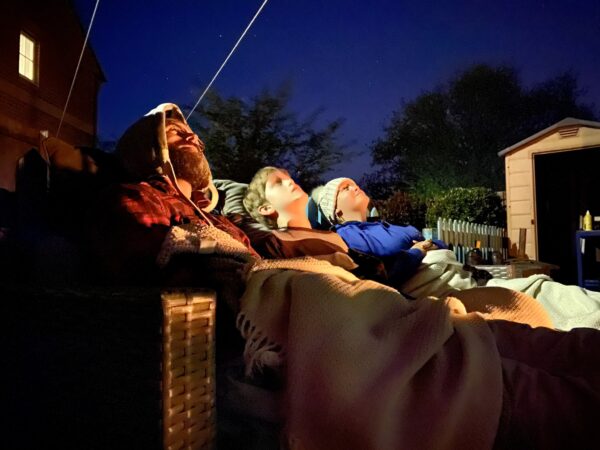
Lay on a reclining chair, blankets on the ground, a trampoline, air bed, or anything you can use to sit or lay on. Blankets or sleeping bags will help if it gets chilly and some drinks and food can help too. It’s great having a picnic under the stars. The most important thing is, that you need to keep your gaze fixed on the night sky. Looking away from the sky means you are guaranteed to miss that bright Perseid fireball.
Blink and You Miss It!
With meteor showers, it can be a case of blink and you miss it. Try your best to resist the urge to keep looking at your phone. If you aren’t looking at the sky, you will miss the meteors. The brightness of the screen will also ruin your night vision and that of others around you. Read this guide or the Guide to Watching Meteor Showers before you go out, resist messaging your mates and leave your phone in your pocket.

What Direction?
A common misconception is that you have to look in a certain direction. This is not true. All you have to do is look up in any direction and fill your gaze with sky. The Perseids will appear randomly in any part of the sky.
The best advice is to look where you have the clearest view, away from trees, lights and buildings. If you were in a field, you would be spoilt for choice for where to look. The human eye can take in over half of the sky.
It is true that the meteors that make up the Perseid Meteor Shower can have their paths traced back to a point in the sky. This is called the radiant. For the perseids, the radiant lies in the constellation of Perseus – The Hero. You don’t have to look here though to see meteors. Many media outlets and astronomy guides lead you to this point in the sky. It’s probably best in my experience to look away from it. South, West, North West and North are my favourites. Probably because I have a dreadful view of the East and North Eastern sky. What direction really doesn’t matter.
What You Can Expect To See
You may sit or lay there for several minutes before you see a meteor/ shooting star. Don’t get them confused with satellites or bits of old rockets and other space junk though. These look like faint stars moving across the sky in various different directions. Some on their own and some with friends, there are many! You will probably see more of these manmade satellites than Perseids unfortunately over the course of an evening. Some Starlink, some rocket components, some military or communication satellites and maybe even the ISS depending on the time and where you are.
Perseid Meteors on the other hand are much more impressive. A meteor literally is a shooting star. A bright streak of light that can last less than a second or more. Some larger meteors appear as bright fireballs with persistent trains that can last a few seconds.
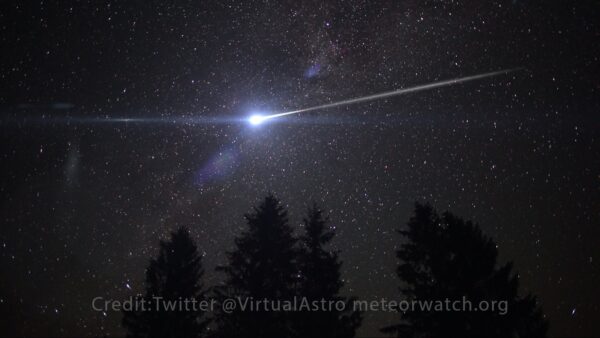
You can wait several minutes and see nothing, or as soon as you look up a meteor streaks across the sky. There is no telling when the meteors will appear. They are very random and impossible to predict when or where they will appear. But when you spot them it is worth the wait. The Perseids are some of the most spectacular sights in the night sky.
At peak on the night of August 11th/ 12th this year, there could be on average 100 meteors per hour. Up to 75 meteors per hour or more could be visible from a dark site.
2023 SHOWS
OCT 15
LONDON WIMBLEDON
NEW WIMBLEDON THEATRE
NOV 18
BRADFORD
ST GEORGES HALL
2024 SHOWS
JAN 6
SUNDERLAND
EMPIRE THEATRE
FEB 24
MONMOUTH
BLAKE THEATRE
Visit The Night Sky Show website for more shows in 2024 and information.
The Moon During The Perseids
During the Perseid Meteor Shower 2023, the Moon will set late afternoon and won’t be a hindrance during the peak of the Perseids. The thin crescent Moon rises again in the small hour and would make for a fantastic meteor moon photo for a lucky astrophotographer.
Those viewing Perseids earlier in the month and during the lead up to the peak evening will also experience darker skies due to the absence of a bright Moon.
What is a Meteor Shower?
Meteor showers are basically a period of time where meteor activity is high. In some cases in the past meteor showers have been so heavy, the meteors literally did look like falling rain.
A meteor is usually an object primarily made of rock or dust that exists in space. They can range in size from microscopic to many meters across. Occasionally the Earth collides with these “meteoroids” or they are trapped in the planet’s gravity. The meteor burns up in the atmosphere as a bright flash of light. Where we get the term “shooting star”. You may see various different colours in the trail of a meteor especially if it is a large fireball. The colour is a result of the elements in the meteor heating up.
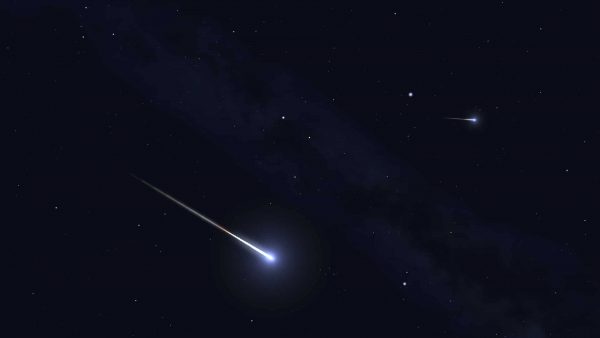
In most cases, meteors burn up as bright flashes or streaks of light. Occasionally larger meteors don’t fully burn up and hit the ground. These are known as meteorites.
Meteor Showers are usually when the earth encounters the debris trail of dust and gravel-sized meteoroids. These are usually left behind by passing comets. With the Perseid Meteor Shower August, the parent comet is Comet 109P/Swift Tuttle. It visits the solar system every 133 years. You can find out more about what Meteors are here.
Enjoy the Perseid Meteor Shower 2023 and make sure you follow VirtualAstro on Twitter and Facebook for guides, info and more on the Perseids 2023 Meteors August.


